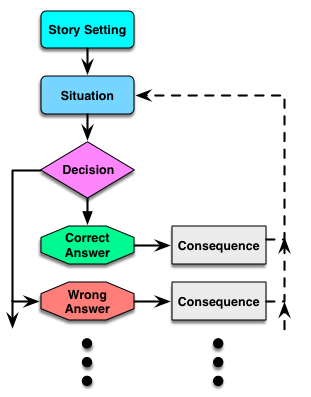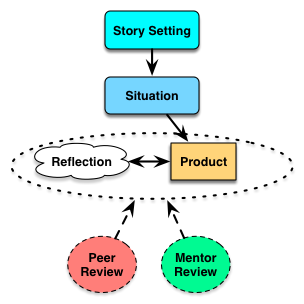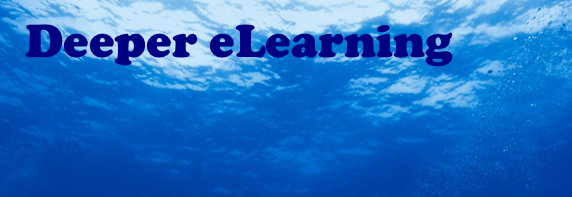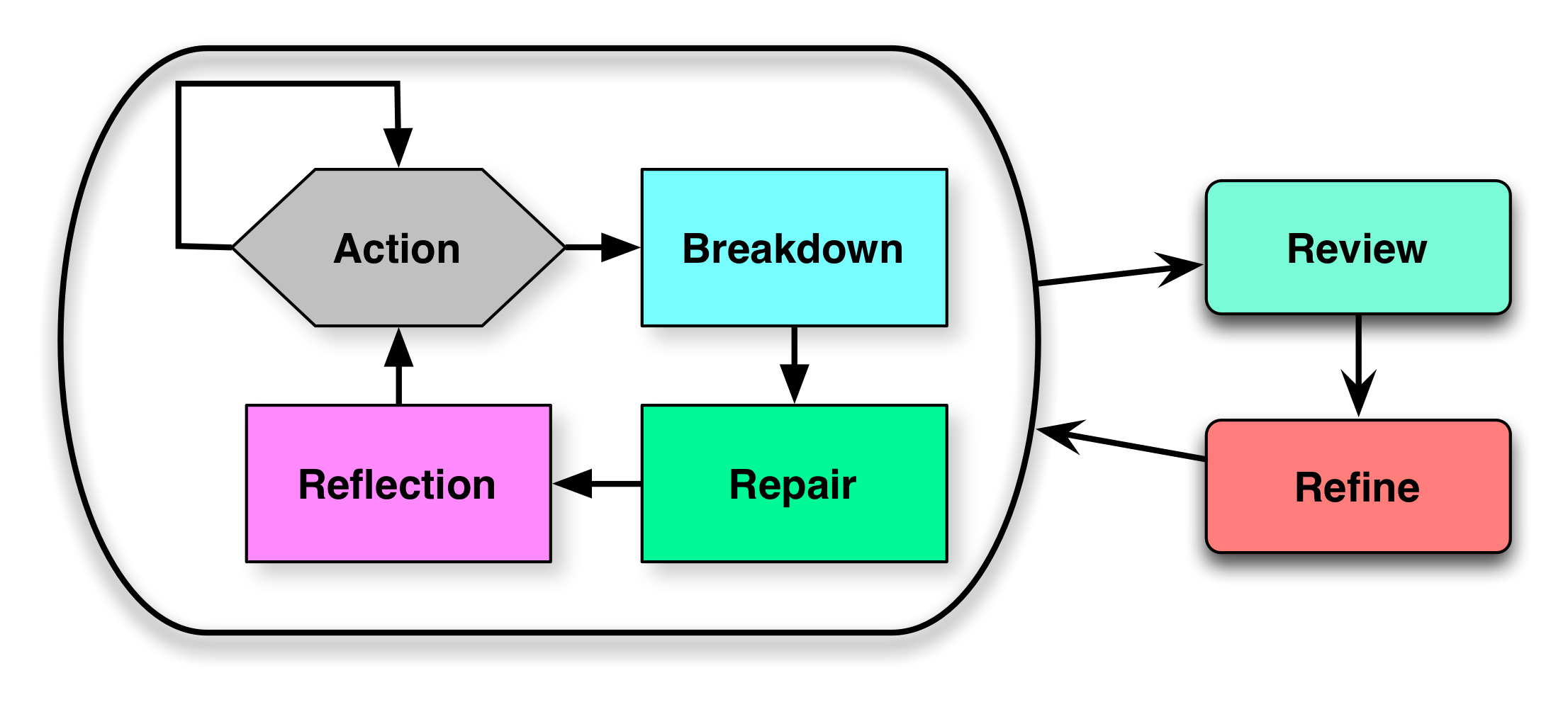In preparing to work with a client on developing their learning science understanding, I realized that I was using two representations about meaningful learner interaction that could be seen to be conflicting. On the one hand I talk about using decisions as a basis for design, and on the other I refer to activity-based learning. And I have separate diagrams for each. What was necessary was reconciling activity and decisions.
 So first, I talk about how we should be putting learners in the place to make decisions like they’ll need to be making after the learning experience. We need to put them in a context, and then a particular event triggers the need for a decision. And then there are options for actions to take. From the design point of view, there are correct answers, and wrong answers. These wrong answers, of course, should reflect where learners go wrong, reflecting reliable misconceptions. People don’t make errors randomly, mostly, but instead reflect inappropriate models being brought to bear. And after their choices, there are consequences. I like for those consequences to be represented first, before the external feedback comes in. This is just a better multiple choice question (or other canned interaction), but…
So first, I talk about how we should be putting learners in the place to make decisions like they’ll need to be making after the learning experience. We need to put them in a context, and then a particular event triggers the need for a decision. And then there are options for actions to take. From the design point of view, there are correct answers, and wrong answers. These wrong answers, of course, should reflect where learners go wrong, reflecting reliable misconceptions. People don’t make errors randomly, mostly, but instead reflect inappropriate models being brought to bear. And after their choices, there are consequences. I like for those consequences to be represented first, before the external feedback comes in. This is just a better multiple choice question (or other canned interaction), but…
If the consequences of the initial decision lead to a new situation and new decisions, now we’re talking a full scenario (whether implemented via branching or a full simulation-driven experience). Note that this is also the structure of a game. In fact, this emerged from game designer Sid Maier’s quote about how games are a series of interesting decisions. Hence, serious games are a series of interesting and important decisions! And, of course, this is programmed in advance (if we’re not talking about online role playing), so learners get feedback without necessary human intervention (though there’re powerful benefits to collecting discussion around the learning challenge).
 However, I also have characterized learning as a series of activities, and those activities generate some work product and are (ideally) annotated with reflections. These products can (and arguably should be) cast as a response to some storyline that has them in a role related to the ones they’re likely to be in after the learning experience (even with some exaggeration). These are complex outputs that are unlikely to be aut0-marked, and can be the basis of either or both of peer or mentor review.
However, I also have characterized learning as a series of activities, and those activities generate some work product and are (ideally) annotated with reflections. These products can (and arguably should be) cast as a response to some storyline that has them in a role related to the ones they’re likely to be in after the learning experience (even with some exaggeration). These are complex outputs that are unlikely to be aut0-marked, and can be the basis of either or both of peer or mentor review.
The benefits here are that when we make the work product reflect real practice, we’re developing a suite of outcomes beyond just the content. We can require different formats – presentations, spreadsheets, documents – developing modeling and communication skills. We can require group work, developing interpersonal skills. And we’re developing time management and project management skills as well. The tradeoff is the amount of mentoring time.
The challenge, then, is to identify the differences, and then think about when you’d use each. The obvious difference is the simpler structure for decisions. While a branching scenario or programmed simulation/game is more than one decision, it’s still more linear than creating a product. Developing a product is typically a series of many decisions! Hence the difficultly for auto-marking, but also the power for learning. It depends on the learning outcome you need, of course. Now, too many activities in a short period of time could tax instructor time, so the best answer (as in many things) is to have a blend.
That’s my reconciliation of activity and decisions. Does it make sense to you? What did I miss?

 In the area of infrastructure, I focused largely on two sub categories, content models and semantics. I’ve been big on the ways that content could be used, from early work I did on content models that led to flexible delivery in an adaptive learning system, a context-sensitive performance support system, and a flexible content publishing system. I’ve subsequently written about content in a variety of places, attended an intelligent content conference, and have been generally
In the area of infrastructure, I focused largely on two sub categories, content models and semantics. I’ve been big on the ways that content could be used, from early work I did on content models that led to flexible delivery in an adaptive learning system, a context-sensitive performance support system, and a flexible content publishing system. I’ve subsequently written about content in a variety of places, attended an intelligent content conference, and have been generally 

